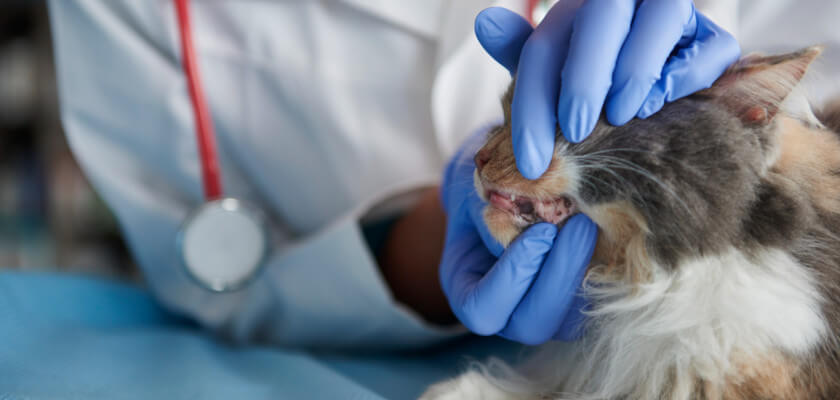Human acne is certainly quite familiar to you. Oily skin and unsightly, itchy spots are a problem that many people struggle with. But did you know that a similar ailment can also affect your cat? Feline acne is a relatively common condition that shouldn’t be a problem for animals in their daily activities. However, do not ignore it – if left untreated, it can lead to various serious complications. Where does this disease actually come from? How can you treat it and prevent it? Read on to find out all about it.
Cat acne – what exactly is it?
Cat acne looks similar to human acne. These are tiny black spots, sometimes with local redness. It most often appears on the pet’s chin, upper lip and mouth. It is not a bothersome ailment until a more serious infection occurs – usually due to insufficient hygiene.
Acne in a cat – causes
The causes of cat acne have not been fully discovered yet. Sometimes the source of the problem simply cannot be established. Possible reasons for the occurrence of this condition are as follows:
- hormonal changes – young, maturing kittens and female cats in heat are most exposed to this phenomenon;
- disturbances or serious diseases of the hair follicles and ducts of the sebaceous glands – specifically the accumulation of keratin masses that cause obstructions and infections;
- bacterial or fungal infection;
- food hypersensitivity or allergy;
- inappropriate shape, material or cleanliness of the bowl with water or food;
- poor animal hygiene – if a cat neglects to wash its mouth, some lesions are inevitable;
- persistently stressed, immunocompromised or improper diets are particularly susceptible to cat acne;
- high temperature is also conducive to the development of acne.
Cat acne – symptoms
The skin lesions most often cover the face or, less frequently, most of the head. They do not appear on other parts of the body. In addition, cat acne can also manifest itself in the following ways:
- black spots (comedones) – shouldn’t be itchy or otherwise bothersome;
- recurrence of dark dots after washing the beard;
- sticky and wet chin hair – if your cat is light-colored, you may notice discoloration of the coat;
- clearly noticeable skin changes – lumps, pimples, scabs and even boils;
- bursting hair follicles and their inflammation;
- redness, swelling and itching of the skin – in the case of bacterial superinfections;
- if the inflammation persists for a long time, lumps, cysts, scars and alopecia are possible;
- in more serious cases, the cat behaves uncomfortably and has clearly less appetite.
Cat acne treatment
If you notice tiny black spots on your cat’s skin, be sure to clean them properly. It is best to do this under sterile conditions so as not to develop an infection. To thoroughly cleanse your cat’s acne lesions, you may need to shave some of its fur.
For washing you need to use warm water and a special disinfectant. Never use preparations intended for humans. Many cats are allergic to strong anti-acne cosmetics. They can cause more harm than good. Finally, apply an antibacterial and healing ointment to the altered skin area. Supplementation with vitamins and minerals may also be necessary.
Cat acne – specialist treatment
The problem persists? Go to your vet. First, he will perform a thorough examination. If possible, he or she will determine the cause of the problem and select the appropriate treatment. Sometimes the cat needs to take steroids or antibiotics to fully resolve the problem.
Correct diagnosis is paramount here as different diseases can cause the same symptoms. A number of different diseases must be excluded here, such as:
- demodicosis;
- yeast infection;
- eosinophilic granuloma;
- atopic dermatitis;
- inflammation caused by the presence of dermatophytes Malassezia.
If none of the above diseases is the cause of skin lesions, the prognosis is quite good.
Cat acne will go away when it is healed, but may recur over time. However, it does not constitute a serious threat to health or life, even in a recurrent form. At best, it can be disruptive and unsightly. The most important thing is not to lead to a bacterial or fungal infection.
Cat acne – prevention
As with any disease, ordinary prophylaxis is more effective than treatment. In this case – proper hygiene. Cat acne is often caused by poorly chosen or rarely washed bowls. Replace them with metal, glass or ceramic. Plastic promotes the growth of harmful bacteria. It’s also best to clean your food and water bowls regularly – after each meal or at least once a day.
Try to immediately remove acne lesions appearing on the skin. If you are not sure how to do it, go to a specialist who will help you with it. Also, learn to help your cat with its hygiene if it has clear problems with it.
Sometimes cat acne comes on and disappears once; sometimes it has a recurrent form. If the cause is a staphylococcal infection, the symptoms will unfortunately repeat, especially during summer and high temperatures.
Cat acne is a relatively common problem that your cat may face at any time in its life. Usually it does not manifest itself with any other symptoms apart from small, black spots on the chin and face. Still, never underestimate this problem. These inconspicuous skin changes may be the beginning of more serious diseases that will be difficult to heal later. Go to a vet for consultation at the first disturbing symptoms.

